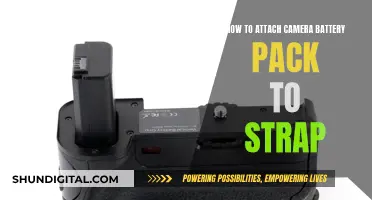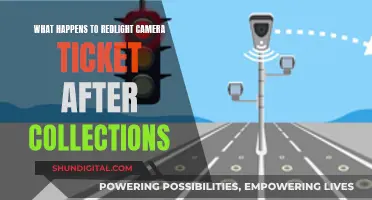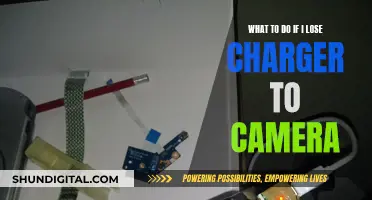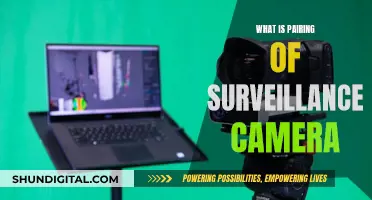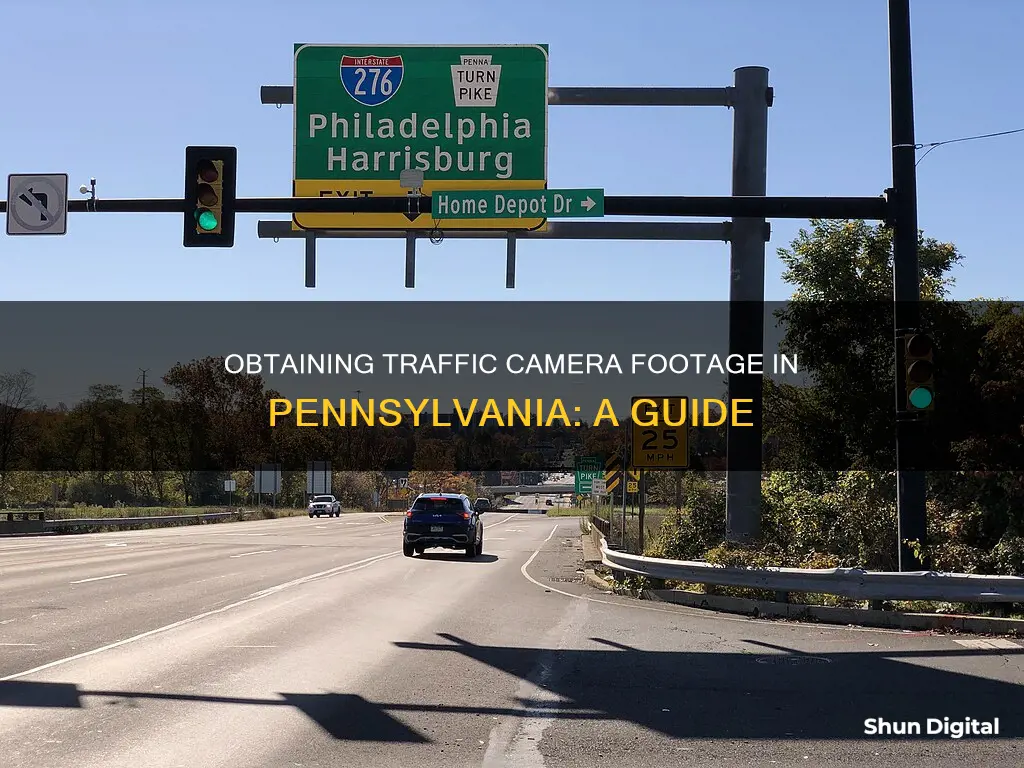
Traffic camera footage can be crucial in the aftermath of a car accident, especially when it comes to proving fault and liability. In Pennsylvania, obtaining such footage can be challenging due to the ownership of the cameras and the lack of infrastructure to retain recorded videos. However, there are ways to access this evidence, which can be essential for victims seeking compensation.
| Characteristics | Values |
|---|---|
| Why is it important to obtain traffic camera footage? | To prove fault in a car accident |
| When might you be able to access traffic camera footage? | When there were no eyewitnesses at the scene of the accident |
| What are the different types of cameras? | Red-light cameras, business cameras, private residence footage |
| Where is traffic camera footage accessible in Pennsylvania? | 511PA Camera List, red light camera footage at PhilaPark |
| How can a lawyer help gather traffic camera footage? | By sending a spoliation letter and issuing a subpoena |
What You'll Learn
- Traffic camera footage is useful for proving fault in pedestrian accidents
- Red-light cameras monitor everyday traffic on roads
- Business cameras are surveillance cameras on businesses that can record accidents in parking lots
- Private residence footage can be obtained from doorbell cameras
- A lawyer can help access traffic camera footage by sending a spoliation letter and subpoena

Traffic camera footage is useful for proving fault in pedestrian accidents
Traffic camera footage is extremely useful for proving fault in pedestrian accidents. In the aftermath of a pedestrian accident, it is crucial to determine the cause of the accident and hold the responsible party accountable. While there are other ways to prove fault, such as eyewitness testimony, police reports, and photographs of the scene, obtaining traffic camera footage can provide undeniable evidence of what occurred.
In Pennsylvania, traffic camera footage is accessible to the public through the Pennsylvania Department of Transportation (PennDOT) and the 511PA Camera List. This footage can be used to prove fault in pedestrian accidents, especially when there are no eyewitnesses present. By reviewing the footage, you can identify the vehicles involved, the speed they were travelling, and the exact point of impact. This information can be crucial in determining who was at fault and can strengthen your case if you decide to pursue legal action.
However, obtaining traffic camera footage is not always a straightforward process. Here are some steps to follow to increase your chances of acquiring the footage:
- Identify the location and jurisdiction of the traffic camera: Determine where the accident occurred and which agency operates the camera. This could be the local police department, the Department of Transportation, or a private company.
- Contact the appropriate agency: Reach out to the agency responsible for the camera and request the video footage. Provide details such as the date, time, and location of the accident. Be persistent but polite in your follow-up calls or emails.
- Provide a release form: In some cases, the agency may require a release form assuring them that you will only use the footage for personal purposes.
- Be prepared to pay a fee: Inquire about any fees associated with obtaining the footage and be prepared to pay if necessary.
- Review the footage: Once you receive the footage, carefully review it and take note of any details that may help determine fault, such as vehicle positions and speeds.
- Seek legal advice: If you are unsure about how to use the footage effectively or need help navigating the legal process, consider consulting an experienced attorney. They can guide you through the process and improve your chances of a successful claim.
It is important to act quickly when requesting traffic camera footage, as agencies may only store footage for a limited time, ranging from a few days to several weeks or months. Sending a spoliation letter, or a preservation of evidence letter, can help ensure that the footage is preserved for your case.
Traffic Cameras in New York: Are They Watching?
You may want to see also

Red-light cameras monitor everyday traffic on roads
Red-light cameras are a common feature of modern driving and they are a type of traffic camera that monitors everyday traffic on roads. They are usually placed at busy intersections to monitor traffic flow and detect violations. These cameras are distinct from other types, such as traffic sensor cameras and speed cameras, as they specifically target red-light runners. In Pennsylvania, traffic camera footage is sometimes needed to prove fault in car accident cases. While real-time traffic footage is available through the Pennsylvania Department of Transportation (PennDOT) and PhilaPark, this data is not archived, so it cannot be used to review past incidents.
Red-light cameras are typically bulky systems with a large camera box and two external flashes, often mounted separately on poles at either end of an intersection. They are usually found in urban areas, particularly at busy junctions that have a high rate of crashes due to violations. When a vehicle enters an intersection on a red light, the camera is triggered by sensors installed in the road, capturing multiple images of the car and its license plate during the violation. In some states, like Washington, the law prohibits capturing the driver's face, so only the rear of the vehicle is photographed.
While red-light cameras are controversial, they serve as an automated ticket-issuing system. If a violation is detected, the motorist will receive a ticket by mail, which is treated as an administrative violation similar to a parking ticket. These tickets are reviewed by a commissioned officer before being issued, and the fines vary depending on the municipality. For example, in New York, a red-light camera ticket is $50 per occurrence. It's important to note that ignoring a ticket can result in it being sent to collections, impacting an individual's credit.
To access traffic camera footage in Pennsylvania for legal purposes, such as proving fault in a car accident, it is often necessary to involve a lawyer. This is because accessing footage from government or private cameras can be complex and may require sending a spoliation letter and issuing a subpoena. Additionally, video evidence needs to be preserved promptly, as it may be erased or deleted soon after the incident.
Evolution of Rearview Cameras: When Did They Start?
You may want to see also

Business cameras are surveillance cameras on businesses that can record accidents in parking lots
Business cameras are surveillance cameras on businesses and/or government buildings that can record accidents that take place in the parking lots or nearby roads. They are an important tool for monitoring your business for safety concerns and accident investigation. Video surveillance can be beneficial to your company, your employees' safety, and your bottom line.
There are several types of cameras that can be used for this purpose, including Lorex, Ring, ADT, and Arlo. These cameras offer features such as local storage, cloud storage, and artificial intelligence that can differentiate between people, packages, and pets.
If you have been in a car accident in Pennsylvania, it is often important to obtain traffic camera footage to prove that you were not at fault. This can be a difficult and complex process, and it is recommended to seek the help of a lawyer. The Pennsylvania Department of Transportation (PennDOT) provides traffic camera footage that is accessible to the public, but it is real-time footage and cannot be used to prove fault for a past accident.
To obtain traffic camera footage of a car accident, you should first identify the owner of the camera and then make an informal request for the video. If the owner agrees, you can get a copy of the footage. If not, you may need to file a formal request or subpoena to obtain the video. It is important to act quickly, as footage may be deleted or overwritten after a short period of time.
Smart Tips for Flying with Camera Batteries
You may want to see also

Private residence footage can be obtained from doorbell cameras
When choosing a doorbell camera, there are several factors to consider. Firstly, look for a camera that offers affordable or free video recording options, as well as cloud or local storage for your videos. This way, you can review footage at a later date if needed. Secondly, opt for a camera with good motion detection and alert features. This will help you stay informed about any activity in your residence. Some cameras even offer custom motion zones and package detection for added convenience.
In terms of video quality, aim for a camera that records in at least 1080p HD. This will ensure that you get clear and detailed footage. Additionally, consider the aspect ratio of the camera. If you want to monitor packages, a head-to-toe view will allow you to see the space in front of your door from top to bottom. Other aspect ratios are also available depending on your specific needs.
Smart home integrations are another important feature to look out for. Compatibility with major smart home platforms will allow you to connect your doorbell camera with other devices, such as smart displays or speakers. This enables features like turning on the lights when motion is detected or using a smart display as a video intercom for your doorbell.
When it comes to power options, it is generally recommended to use wired doorbell cameras whenever possible. They tend to be more reliable, require less maintenance, and are often more affordable. However, if wiring is not an option, look for a doorbell camera with removable or rechargeable batteries to make recharging more convenient.
Overall, doorbell cameras can be a great way to enhance the security of your private residence and obtain valuable footage. By considering your specific needs and the features offered by different models, you can choose the best doorbell camera for your home.
Understanding Aperture Mode: Creative Control Over Your Camera
You may want to see also

A lawyer can help access traffic camera footage by sending a spoliation letter and subpoena
In Pennsylvania, traffic camera footage can be crucial evidence in the aftermath of a car accident, helping to prove who was at fault. This is especially important if there were no eyewitnesses at the scene. However, accessing this footage can be challenging. This is where a lawyer can help by sending a spoliation letter and subpoena.
A spoliation letter is a document sent to the other party involved in the accident, notifying them that they must preserve specific evidence relevant to the case. This could include any footage they may have captured of the incident, as well as other pertinent information. The recipient of the letter is then obligated to ensure that no evidence mentioned is lost or discarded. Sending a spoliation letter is a proactive step to prevent the destruction of evidence, which could hinder your ability to seek compensation or prove your case.
In the context of traffic camera footage, a spoliation letter would be sent to the entity that controls the camera, such as a government agency or a private company. The letter would request that they preserve the footage and provide it to you for your case. Without a spoliation letter, the entity may delete the footage after a certain period, as they are not typically required to retain it indefinitely.
If the entity does not comply with the spoliation letter, the next step would be to issue a subpoena. A subpoena is a court order that requires the entity to produce the requested documents or footage. Failing to comply with a subpoena can result in legal consequences, such as being held in contempt of court.
The process of sending a spoliation letter and issuing a subpoena can be complex and time-consuming. A lawyer can guide you through this process, ensuring that all the necessary steps are taken to obtain the traffic camera footage. They can also assist in drafting the spoliation letter to include all the relevant information and ensure it is sent to the correct entity.
It is important to act quickly after an accident to ensure that any relevant footage is preserved. By consulting a lawyer and taking the appropriate legal steps, you can increase your chances of obtaining the traffic camera footage and building a strong case to support your claim.
Turn Off Burst Mode on Galaxy S8 Camera
You may want to see also
Frequently asked questions
Traffic camera footage can serve as valuable evidence to determine fault and prove negligence in the event of a car accident. It can be particularly useful if there were no eyewitnesses at the scene.
Obtaining traffic camera footage in Pennsylvania can be challenging. The footage is often maintained by law enforcement agencies or private entities, and you may need to send a spoliation letter or issue a subpoena to gain access. Consult a lawyer for guidance on navigating this process.
Common types of traffic cameras in Pennsylvania include red-light cameras, which monitor everyday traffic and capture vehicles running red lights; speed cameras, which use radar to detect speeding vehicles; and Automatic Number Plate Recognition (ANPR) cameras, mounted on police vehicles to identify license plates.
Look for the presence of red-light or speed cameras near the accident site. Consider the location, such as whether it was near an intersection or a busy highway. Contact your lawyer and provide them with the accident's location details, and they can assist in uncovering any available traffic camera footage.
In the absence of traffic camera footage, there are alternative strategies to prove negligence and strengthen your claim. Ensure you collect critical information from the other driver, such as their name, contact details, insurance information, and vehicle details. Additionally, gather eyewitness testimonies, take photographs and videos of the accident scene, and obtain a copy of the police report.


